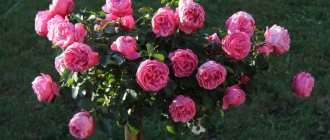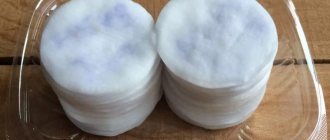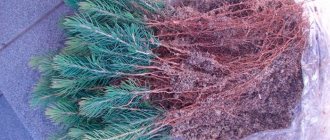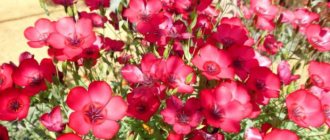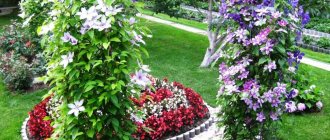Euphorbia marginata or Mountain snow is also called Euphorbia marginata. They came up with this name because its flowers and foliage resemble beautiful snow globes. It has green leaves edged with white. Euphorbia fringe began to be grown in the 19th century.
It grows naturally in the mountains of North America.
This plant is an annual. Attention! Euphorbia Mountain Snow is poisonous; the leaves and stems contain a milky sap that has poison - euphorbine.
What does bordered spurge look like, what family does it belong to?
Euphorbia bordered has many names that characterize its appearance and habitat - “early snow”, “mountain” or “rich bride”. The shrub belongs to the Euphorbiaceae family and grows no more than 80 centimeters in length.
Bordered spurge grows on mountain slopes
On a note! The length of the plant and the stem are the same, since it has erect shoots on which elongated oval leaves are located. They are painted in a beautiful green shade with blue tints, and its edges are bordered by a snow-white stripe.
Common varieties
The most popular varieties of milkweed Early Snow are:
- Summer Icicle - 40 centimeters in height, whorled leaves are light green and have a white edge along the entire edge;
- Early Snow - similar to the previous variety, but has more noticeable flowering with white buds.
Medicinal properties
Euphorbia tinctures have long been used in folk medicine to treat various ailments. The plant has healing properties:
- increases immunity;
- treats external inflammatory processes;
- reduces itching and other dermatological problems;
- starts the proper functioning of the gastrointestinal tract;
- relieves stomach pain due to poisoning.
Briefly about the history of appearance
The plant is native to the mountain slopes of Canada and the northern states of America. It has been grown as a garden ornamental plant relatively recently.
general characteristics
Botanical name - Euphorbia marginata (lat. euphorbia marginata). Belongs to the Euphorbiaceae family. The shrub is popularly called Mountain or Early Snow.
A herbaceous bush with numerous branches, densely covered with variegated foliage - in appearance it resembles lace and is a bright decoration of the site.
The plant is characterized by intensive growth - during the season the stems can reach 80-90 cm in length, the crown circumference - 70-75 cm.
Description:
- depending on the time of year, the shade of the leaves changes: in spring it is light gray, in summer during flowering it is snow-white;
- small white flowers bloom at the top of the stems, which give the bush additional decorativeness;
- long-lasting flowering - begins in mid-summer and ends in early autumn;
- after the inflorescences dry out, seed pods form, later they crack and the seeds scatter in different directions;
- In its natural environment it reproduces by self-seeding.
This species is an annual, although some consider it a perennial. White-edged spurge has poor frost resistance, so it freezes during the winter even in the slightest frost.
Features of flower care at home
Euphorbia cypress - how to care at home
Like other varieties of milkweed, bordered also does not have any special care requirements.
Temperature
For normal growth, a temperature ranging from 18-26 ℃ above zero is required. The shrub is resistant to heat, but can also withstand short frosts without negative consequences.
The bush is planted in an open place
Lighting
It is better to plant milkweed in an open place, otherwise it will weaken and may die. If the plant is planted next to buildings, then it is better to choose the southern side for this.
Note! If the bush will be grown in southern latitudes, an area with slight partial shade will be suitable.
Watering
Mountain spurge is rarely watered, otherwise there may be a risk of rotting of the root system. Water the plant only when necessary; during the rainy season, this need disappears completely.
Spraying
There is no special need to spray. The shrub easily tolerates drought and does not suffer from high temperatures.
Humidity
Humidity indicators, like spraying, do not play a special role in care, so you can not pay attention to this point.
Priming
For planting, choose a place with deep groundwater, since the plant does not like high humidity. Due to excessive feeding, milkweed may stop developing, so you should not carry out the procedure too often.
Feeding
Fertilizers play a big role in the care of ornamental plants, but not in the case of bordered milkweed. It is enough to feed it once a month with mineral fertilizers.
Note! The first and last application of fertilizers is best done using organic matter: manure, mullein, humus.
Feeding, pruning
If the land on your site is very fertile, then Euphorbia marginalata does not need to be fed. If the soil is depleted, fertilize it with mineral or organic fertilizers. An excellent option is a manure solution. To prepare it, dilute 200 grams in 10 liters of water, stir the substance well, and leave for a day. The soil is fertilized with this solution in the evening.
The snow-like Euphorbia marginata is a member of the Euphorbia family, which means its juice is poisonous. Pruning this plant almost to the root. If a lot of root shoots have formed over the summer, cut off the excess ones too.
The most beautiful Snow on the mountain does not get sick and is not attacked by harmful insects. The plant is protected from the latter by poisonous sap, and its resistance to diseases is due to its powerful immunity. Euphorbia marginata successfully tolerates even bad weather, if it is not prolonged rains.
Such a beautiful flower is widely used in landscape design because it combines well with other garden crops. It looks no less excellent as part of bouquets, especially together with delphinium, mallow and dahlias.
Olga Danilina
Features of care in winter, rest period
Garden spurge (Euphorbia) - description of multi-flowered, marsh species
By the end of summer, all care procedures are stopped and sanitary pruning begins. For the winter, you don’t have to cover the spurge or simply cover it with dry leaves and soil. in more northern regions they can be covered with spruce branches.
Flowers of edged milkweed
Flower garden partners
Euphorbia fringe will be a good backdrop for bright flowers. It will perfectly highlight the splendor of roses. Euphorbia will be an organic complement to bright gladioli and delicate irises.
Euphorbia will effectively complement a landscape composition with phlox and dahlias. When planted next to phloxes, it will help emphasize them. And bright multi-colored perennials can look more elegant. The airy pattern of milkweed will be a good addition to any flowers.
Euphorbia is not only beautiful, but also beneficial, repelling insects and rodents. Planting it around the perimeter will help preserve the beauty of flower beds.
When and how does it bloom
Euphorbia flower Milya - how to care for it at home
The flowering of mountain milkweed is invisible, as it is lost against the background of variegated leaf blades.
Types of flowers
Very small white flowers are collected located at the very top of the stems. In the very middle, yellow-green stamens are very noticeable on them. Because of their shade, the buds practically merge with the background of large white-green leaves.
Flower shapes
Umbrella-shaped inflorescences have from 3 to 7 flowers, each of which includes 5 petals. The buds look like daisies with wide semicircular petals
Flowering period
Flowering of early snow begins in late May and lasts until mid-June. Towards the end of summer, a second wave begins, which is not as abundant as the previous blooming of buds.
Useful video
From the video you will learn where to plant and how to care for Euphorbia bordered:
All details about the care, propagation and cultivation of milkweed, as well as a description of the species of this plant, can be found in separate materials on our website. Read about these varieties: Mountain Snow, White-veined, Many-flowered, Cristata, Comb, Fat and Wild.
How does edged spurge propagate?
Euphorbia of this subspecies is propagated in two ways: seeds and cuttings.
Seeds can be grown as seedlings
Germination of seeds
Cultivation of edged milkweed from seeds is carried out in the first half of May. Planting material is planted immediately in open ground, but seedlings are grown in a box. Initially, the soil is dug up and organic matter is added to it, after which the plant is not fed for 2 months. Make small holes 5 centimeters deep. They plant a seed in them and water them. After the sprouts appear, weak and short specimens are removed.
Rooting cuttings
To grow milkweed from a cutting, a branch is cut from an adult bush. Soak it in water for a day and plant it in a nutritious loose substrate. After three weeks, the cuttings will take root and can be planted in open ground.
Reproduction
At home, spurge propagates in 3 ways:
- seeds;
- cuttings;
- dividing the bush.
The soil for flower propagation should consist of the following components in equal proportions:
- sand;
- leaf soil;
- peat.
Cuttings
Pros:
- Easy and fast.
- You can propagate in this way at any time of the year.
Cons: Extra caution is required as milkweed sap is highly poisonous.
Important! When propagating from cuttings, you must use protective gloves.
Step-by-step diagram:
- pinch off a leaf with a stem;
- let the milky juice drain;
- Next, the cut should be treated with a stimulator;
- plant the cuttings in moist soil;
- cover with transparent film or cap.
Seeds
The advantages of growing “early snow” from seeds: you can get several plants at once.
Minuses:
- Only fresh seeds can be used.
- It is not a very fast method and requires some effort.
Step-by-step diagram:
- The seeds of milkweed are round, about 2 mm in diameter, so they need to be carefully sprinkled with the same thin layer of soil.
- Thoroughly moisten the substrate.
- Cover with a glass cap.
Dividing the bush
Pros: easy and fast.
Cons: dividing the bush can only be done when the plant is not blooming and is dormant (winter months and early spring).
Step-by-step diagram:
- Remove the mature plant from the pot.
- Divide the rhizome into several parts.
- Carefully inspect the planting material for rotting areas. Remove unhealthy parts.
- The plant is taken out of the pot and the rhizome is divided into several parts.
- Place the finished divisions in separate pots.
Transfer
Planned replanting of mountain milkweed is not required, but sometimes unforeseen circumstances arise due to which the bush has to be moved to another place. Such circumstances include an incorrectly selected planting location or rotting of the root system.
Step-by-step transplantation is carried out as follows:
- Dig up the bush and clear the roots from the soil.
- Cut off dead rhizomes and stems.
- The cuts are processed and the plant is placed in a saline solution that stimulates root formation.
- Dig a hole in another place.
- Euphorbia is placed in it.
- Cover with substrate and compact.
Bloom
The flowering period begins in July and ends with the onset of the first frost.
The flowers are small and white.
An amazing feature of “early snow” is that at the time of flowering, a bright white border appears on the upper leaves located under the unsightly flowers.
The plant appears to be decorated with huge caps of flowers.
This magical transformation justifies one of its names - “rich bride”.
Possible problems in cultivation and diseases
All varieties of milkweed are characterized by special resistance to diseases and pests. They tolerate the negative consequences of unfavorable climatic conditions well, but small problems appear in them.
Drops buds and leaves
The shedding of leaves and flowers is a consequence of lack of fertilizing and lack of lighting. Often before this, the foliage and petals of the buds begin to dry out at the edges.
The leaves are turning pale
The most important reason for plate fading is the lack of natural light. An important element in caring for milkweed is choosing a suitable site.
The tips of the leaves are drying out
The problem rarely bothers mountain spurge, but if it does appear, the bush suffers from prolonged exposure to the scorching sun with dry air and lack of watering.
The lower leaves fall off
The falling of the lower leaves occurs due to a sharp change in temperature or lack of phosphorus in the soil. The problem also arises if the plant is planted in low-lying areas, close to groundwater.
Pests
Insect parasites that attack Euphorbia edum include scale insects, aphids, and spider mites. You can notice their appearance on the leaf plates; small dark dots form on them.
Additional Information! Spider mites weave thin webs, and scale insects and thrips lay larvae on the underside of leaves. Insecticides are used to combat them, but the most effective way to combat spider mites is with acaricides.
Brief description of the plant
The stem of bordered milkweed is long and thin, its height can vary from 20 to 80 cm. Numerous oval foliage is colored light green, the size of an individual leaf does not exceed 5 cm (see photo).
The flowering of “mountain snow” begins in June and continues until late autumn. It is during this period that spurge throws out small light inflorescences and transforms its leaves. A snow-white border appears on them, which, in combination with light buds, gives the plant a decorative appearance.
Bordered spurge is poisonous - its juice is dangerous to humans and can cause poisoning. However, growing it in flowerbeds is safe if you follow basic rules of protection - the main thing is to prevent the milky juice from getting on your skin or eyes. You can plant a plant in a flowerbed only once - although it is not a perennial, it will reproduce well in subsequent seasons by self-sowing.

